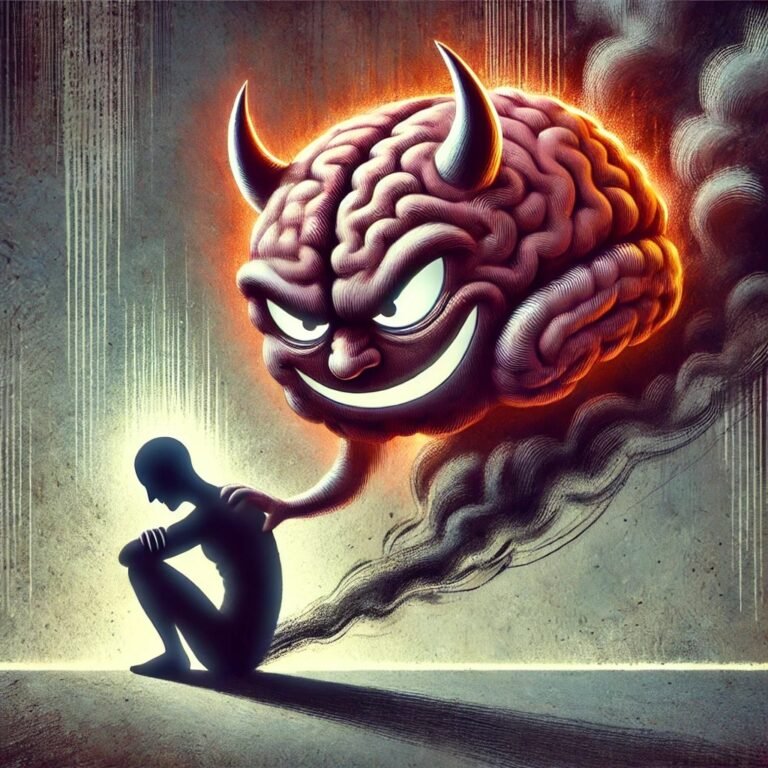
Have you ever heard that little voice in your head whispering doubts, delaying your dreams, or questioning your worth? That’s your ego, and despite what it might tell you, it’s not your amigo. While the ego might feel like a necessary part of who we are, it’s actually more like a cage—an illusion that encases our soul and limits our infinite potential.
But what is the ego, really? Does it even exist? And if it doesn’t, why does it have so much control over our lives? Let’s dive deep into understanding the ego, its mechanisms, and how it holds us back. By the end, you’ll see why the ego isn’t your friend—and why learning to manage it can change everything.
What Is the Ego?
The ego is the part of our mind that creates our sense of self. It’s the voice that says, “I am this,” or “I am that.” But here’s the kicker: the ego isn’t real. It’s not a tangible entity but a construct, a collection of programs, beliefs, and patterns formed by past experiences, societal conditioning, and fear.
The ego’s job is simple: to protect you. It acts as a survival mechanism, helping you avoid physical harm. But the problem is that it oversteps its bounds, extending this protective instinct into areas where it doesn’t belong, your relationships, goals, and sense of self-worth.
The Ego’s Biggest Lies:
-
- “You’re not good enough.”
-
- “What if you fail?”
-
- “You need to be in control.”
-
- “Change is dangerous.”
Sound familiar? The ego thrives on fear, creating stories to keep you from stepping out of your comfort zone. But here’s the truth: these stories are just illusions.
The Ego and Fear: A False Reality
If the ego isn’t real, then neither is the fear it generates. Fear is often described as False Evidence Appearing Real, and that’s exactly how the ego operates. It takes past experiences, magnifies them, and projects them onto the present or future, making you believe that danger is imminent, even when it’s not.
How Fear Works:
-
- You consider taking a bold step, like starting a business or leaving a toxic relationship.
-
- The ego whispers, “What if it fails? What if you’re not good enough?”
-
- Fear paralyzes you, keeping you in the same patterns and preventing growth.
In truth, the ego isn’t protecting you, it’s trapping you. Its primary goal is to maintain the status quo, even if that status quo is limiting or harmful.
The Mechanisms of the Ego
The ego operates like a computer running outdated programs. It replays the same thoughts, beliefs, and fears, creating a loop that’s hard to escape. For example:
-
- You know you need to hit the gym, but the ego says, “How about tomorrow?”
-
- You dream of starting a passion project, but the ego says, “What if people laugh at you?”
These mechanisms are designed to keep you “safe,” but in reality, they’re keeping you small. The ego resists anything that could make you freer, grander, or more aligned with your true self.
Ego’s Favorite Tactics:
Procrastination: Delaying action to avoid discomfort.
Self-Doubt: Convincing you that you’re not capable.
Comparison: Making you feel inferior by measuring yourself against others.
Control: Insisting that you micromanage every aspect of life, leaving no room for trust or spontaneity.
You Are Not Your Ego
Here’s the most liberating truth: You are not your ego. At your core, you are infinite potential, a being of love, creativity, and boundless possibility. The ego is just a mask, a false identity that limits who you think you are.
Think about it: When you’re truly in the moment, lost in creativity, joy, or love—where is the ego? It fades into the background. That’s because your true essence is beyond the ego. It’s the part of you that dreams big, loves deeply, and trusts the flow of life.
Why the Ego Resists Change:
The ego sees growth as a threat. If you step into your true potential, the ego loses its grip. That’s why it resists anything that challenges its control, whether it’s healing past wounds, pursuing your dreams, or embracing love.
What Should the Ego Do?
While the ego isn’t your amigo, it does have a role to play. Its primary function should be to protect you from physical harm—nothing more. It’s the part of you that keeps you from stepping into oncoming traffic or touching a hot stove. Beyond that, the ego’s job is done.
But here’s the problem: the ego doesn’t know when to stop. It tries to control every aspect of your life, running outdated programs that create the same outcomes over and over again.
How to Build a Healthy Ego
The good news? You can learn to manage the ego, limiting its influence while allowing your true self to shine. A healthy ego isn’t about dominance or control—it’s about balance.
Steps to Building a Healthy Ego:
-
- Recognize Its Tricks: Awareness is the first step. Notice when the ego is trying to take over.
-
- Challenge Its Stories: Ask yourself, “Is this thought based on truth or fear?”
-
- Focus on Growth: The ego resists change, but your soul thrives on it. Embrace discomfort as a sign of progress.
-
- Cultivate Self-Compassion: A healthy ego allows you to acknowledge your flaws without judgment.
-
- Practice Presence: When you’re fully in the moment, the ego has no power.
To learn how to developing a healthy ego, check out our blog post: Developing a Healthy Ego: What It Is and Why It Matters.
Freeing Yourself from the Ego’s Cage
The ego is not your amigo. It’s a false identity that limits your potential, creates unnecessary fear, and keeps you stuck in repetitive patterns. But here’s the truth: you are not your ego. You are infinite potential, capable of living a life of freedom, joy, and alignment.
By recognizing the ego’s tricks, challenging its stories, and building a healthy relationship with it, you can break free from its cage and step into your true power. Remember, the ego’s role is limited—its job is to keep you safe, not to run your life.
So, ask yourself: What would your life look like if you stopped listening to the ego and started trusting your true self? The answer lies in letting go, embracing growth, and living fully in the present moment.
Let’s Keep the Growth Going
You’ve come this far for a reason. Stay connected and receive insights that meet you where you are—right in your inbox.
- Join our Newsletter -
Share:
Leave A Reply Cancel reply
Categories
- A Course in Miracles - Weekly Study Guide 2
- Ancient Wisdom 14
- Book Summaries 20
- Coach G's Journal 55
- Conscious Motherhood 7
- Conscious Pregnancy 2
- Conscious Women 30
- Gloria’s Journal 6
- Life Coaching 80
- Marriage & Relationship 20
- Parenting 5
- Productivity 11
- Quantum Psychology 75
- Self-Improvement 103
- Spirituality 57
- Top Business Coaching Strategies 9
Popular Posts
The Monster Within: Embrace Your Shadow and Discover True Strength
Tags
Useful Links
Quick Menu
Contact Us
- +971585541780
- info@coach-g.com
- Al Murjan tower, Al Marsa Street Dubai Marina
© 2025 COACH G.





Comments